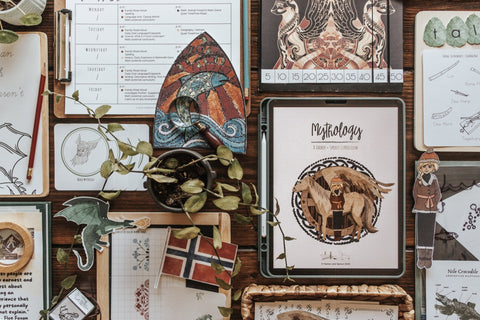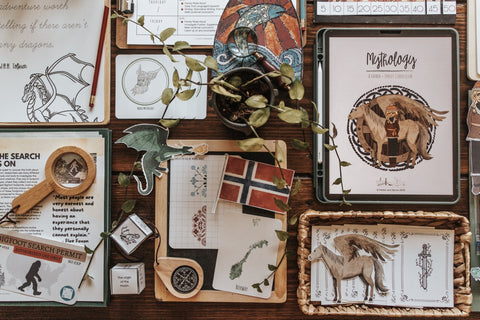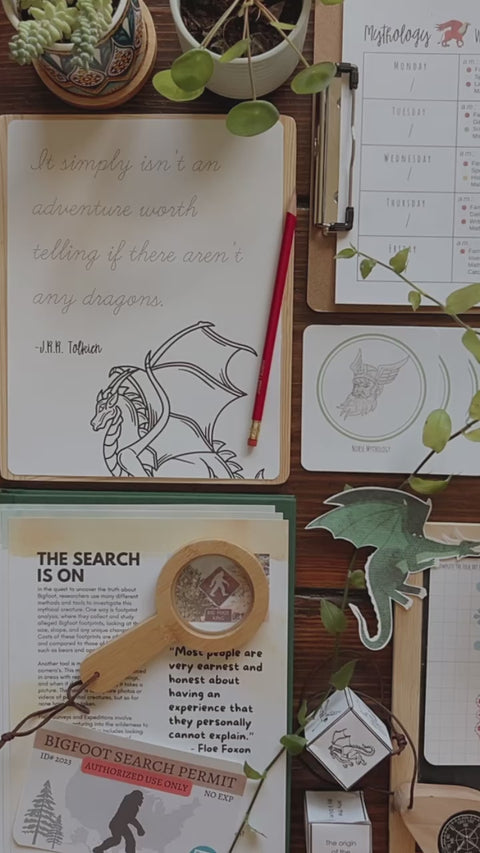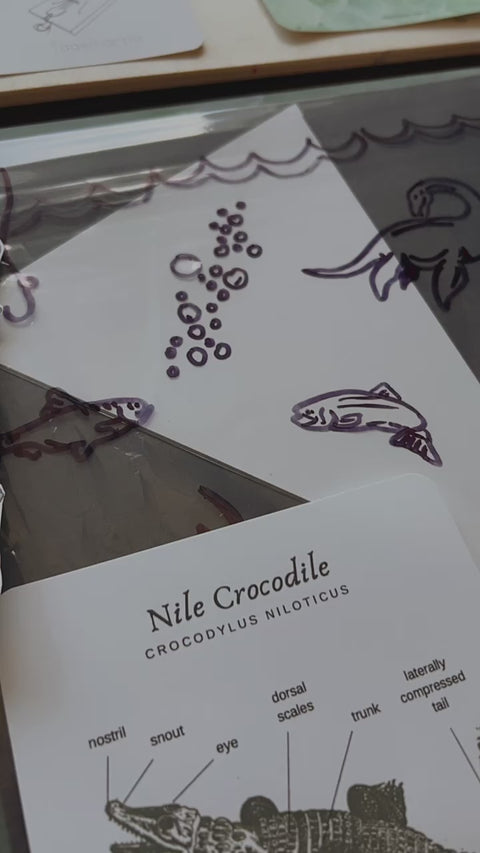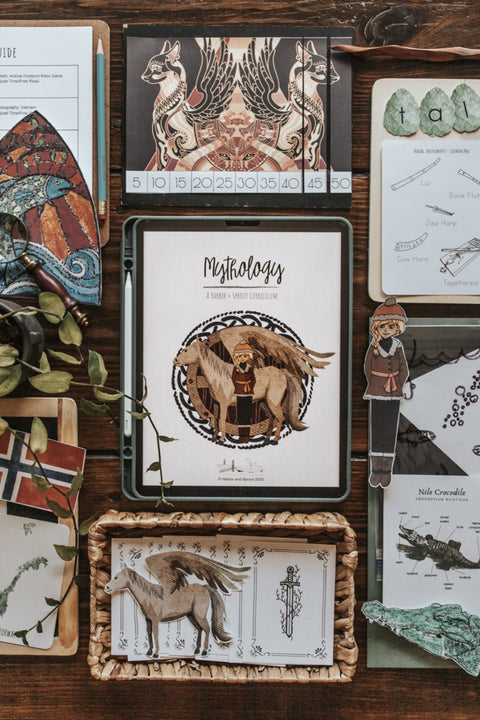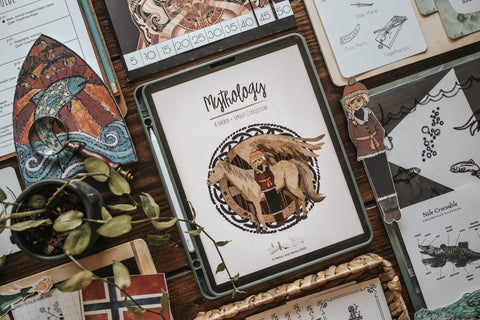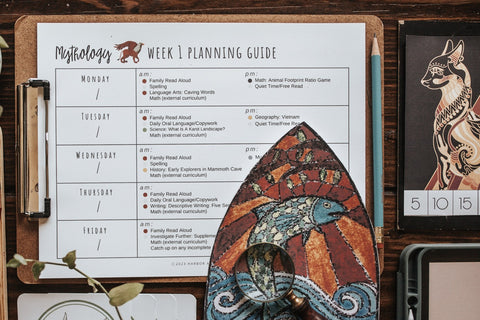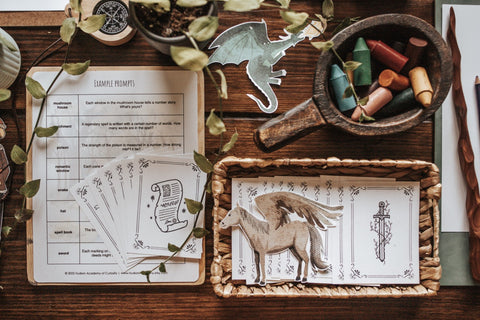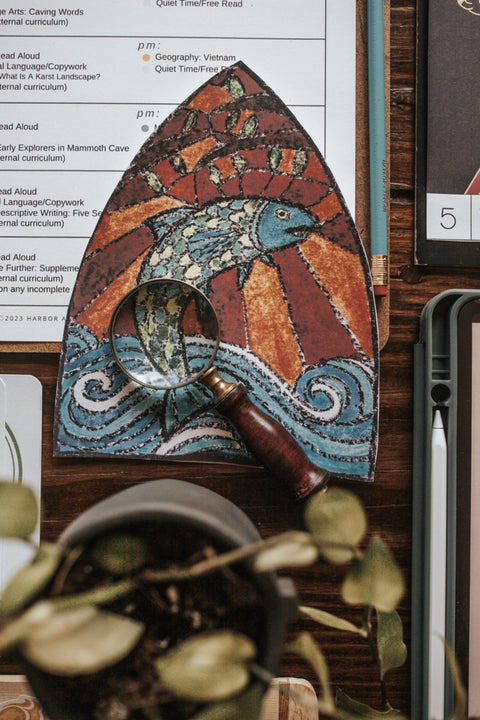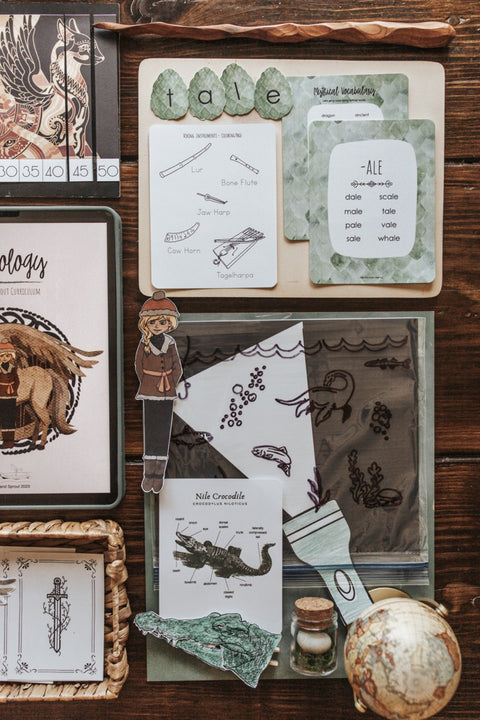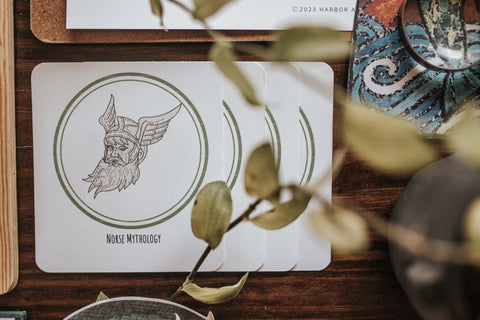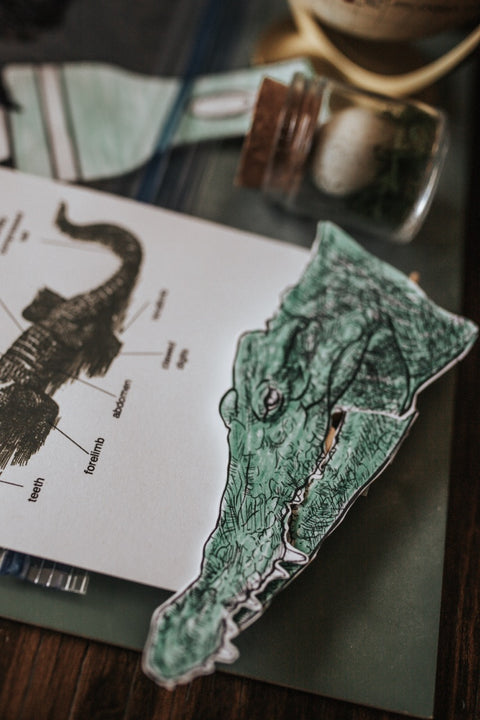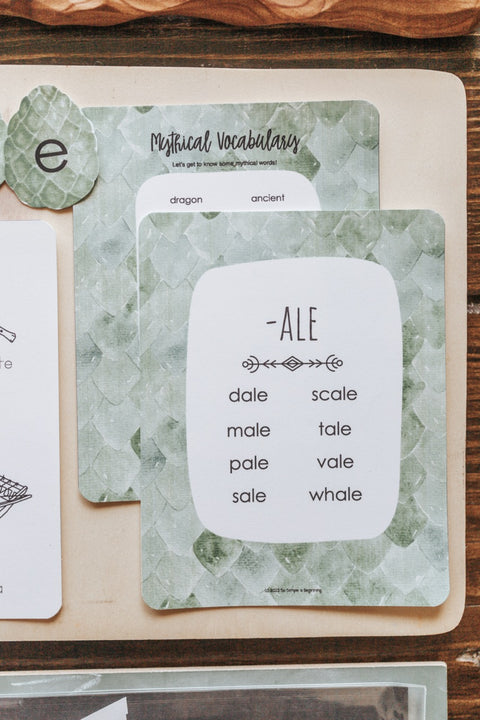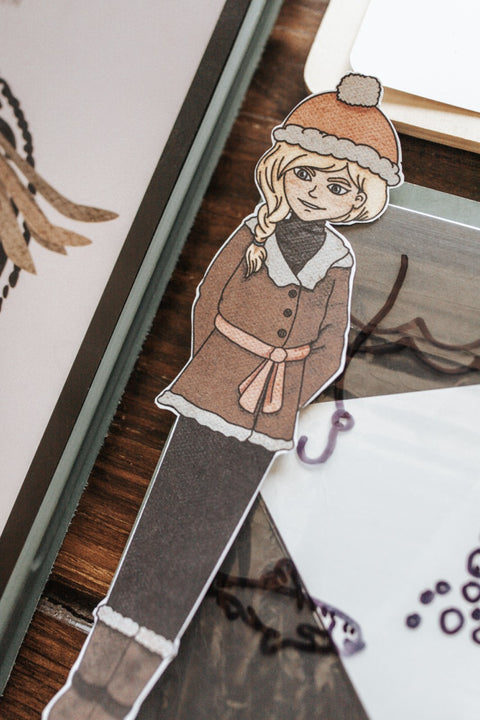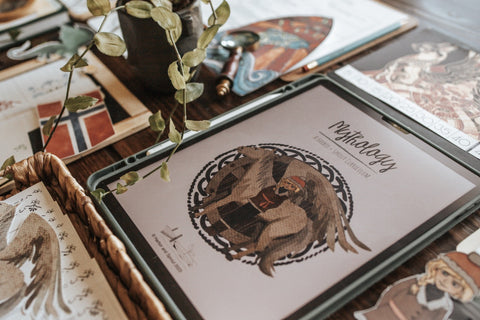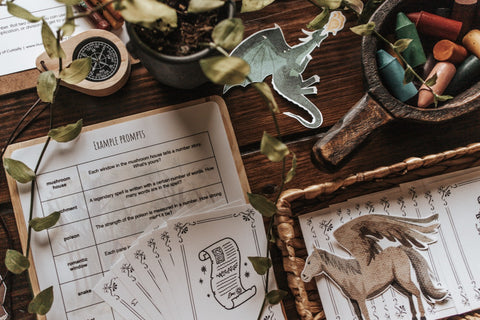Harbor and Sprout
Mythology Patchwork Study
Welcome to the Harbor + Sprout Mythology Patchwork Study, the November 2023 release of our original elementary-level homeschool unit study curriculum. This unit study features 4 weeks of lesson plans and materials covering all 9 of our core subjects and a playful supplemental section of thematic activities. This unit study is meant for use by children ages 3-12.
This unit is delivered via a secure link as a digital download.
CONTENT:
Handbook
Daily, weekly, and monthly planning pages
Book list including stories, poems, and field guides with recommended ages, subject correspondence, and brief summaries for each title
Lesson plans for 4 levels of learning
Family read aloud with discussion guide and recipe
Character kit- new monthly character illustrated by Stephanie Groves to act as your guide through the unit
Science
Week 1: What is Mythology?- Imagine a time long ago when people didn't have scientists, books, or the internet to answer their questions. They looked to the skies, the earth, and the mysterious forces around them and wondered how it all came to be. They told stories to explain the unexplained, to make sense of the world, and to pass down their wisdom to the next generation. These stories are what we call myths.
Week 2: What Can We Learn From Myths?- Mythology has played a unique role in the history of science. While it's not a scientific method itself, it sparked early scientific thinking and curiosity.
Week 3: Can You Prove a Myth is True?- In lesson 2 we explored how modern science and technology have been used to disprove or “debunk” several ancient mythologies. What if you learned that despite all our knowledge, research, and understanding of our world, there are still some puzzles out there that are yet to be solved?
Week 4: Can You Trust Your Eyes?- Sometimes, our eyes can play tricks on us, especially when we're not expecting to see something extraordinary. While these legends are super exciting, it's a good idea to be a little skeptical and use our scientific tools to separate fact from fiction.
Nature Study
Week 1: The Nile Crocodile and Sobek- Learn about one of our world's most ferocious predators and meet a powerful Egyptian deity, the lord of the crocodiles, Sobek. In this lesson, you will discover how the Nile crocodile is uniquely adapted to life in the river as its apex predator, explore the role of Sobek in Egyptian myth, paint a protrait of Sobek on your own papyrus paper, conduct an experiment to see the significance of the Nile's seasonal floods, and celebrate the crunching power of a crocodile with a munching craft.
Week 2: The Cat and Bastet- Meet one of Egypt's most cherished animals and the powerful deity, Bastet, that chose to adopt their likeness. In this lesson, you will explore the role of the domestic cat in Egyptian society, learn how cats are uniquely adapted to huntress life, meet the cat-headed Egyptian deity Bastet and identify her role in myth, sculpt a Bastet-inspired statue, create a sistrum, and discover the secret behind a cat's agility with a cat spine model.
Week 3: The Ibis and Thoth- Travel to the banks of the Nile to observe the ibis, a nearly soundless bird, and meet the god of magic and wisdom, Thoth, who often appeared in their form. In this lesson, you will discover how the sacred ibis is uniquely adapted to life in the marsh and explore the physics behind their migratory v-formation, explore the role of Thoth in Egyptian myth, learn how to write your name in hieroglyphs on a cartouche, be Thoth's apprentice and begin a collection of daily scrolls, and create a flying ibis craft.
Week 4: The Jackal and Anubis- Journey with us to the catacombs to meet the god of the underworld and his canine counterpart. In this lesson, you will meet the Egyptian jackal and discover its unique adaptations for life in the desert, explore the role of the jackal-headed deity Anibus, conduct a mummification experiment, sculpt a sacred Anibus mask, and discover how jackal teeth are designed for their scavenger diet and compare it with our own. Are you ready? Let's go!
Language Arts
Week 1: Mythical Words- Grow your vocabulary by studying the -ale word family. Familiarize yourself with words commonly used in mythology & learn their origins. Practice spelling with a dragon egg spelling activity, and showcase your new vocabulary words in a story of your own writing.
Week 2: The Hunting of the Dragon- Enjoy the allegorical poem "The Hunting of the Dragon" written by the English writer G.K. Chesterton (1874-1936). An allegory is a poem, story, or picture that uses symbols to convey a hidden meaning.
Week 3: Possessive Pronouns- Possessive pronouns are a type of pronoun that is used to show ownership of something by someone. Learn all about possessive pronouns through a matching activity and a magical dragon’s treasure game.
Week 4: Myths- Understand what makes a myth by watching and discussing the Greek myth about Hades & Persephone. Take your learning a step further by writing a myth of your own.
Writing
Week 1: Rhyming in Poems- Poetry is a unique form of writing. Poems are full of imagery and descriptive language. There are many, many different kinds of poetry. Many poems and songs have rhyming words in them. This makes them easy to remember and fun to read because it creates a rhythm in the poem. Let’s continue learning about rhyming and poetry!
Week 2: Meter in Poetry- Meter simply means the beat and rhythm of the poem. A poem with a solid meter moves along at a predictable beat. For our purposes this week, we will introduce the concept of meter and briefly discuss one common form of meter in poetry.
Week 3: Cinquain Poems- This week we are going to learn about a special form of poetry called a cinquain. A cinquain is a short poem meant to describe something, following a very specific format.
Week 4: Diamante Poem- A diamante poem is similar to a cinquain poem. It does not rhyme. There are a set number of lines and each line has its own rules. However, there are a few differences between a diamanté and a cinquain. Read examples and then create your own diamante poem.
History
Week 1: Egyptian Mythology- Every morning people in Ancient Egypt awoke to the sun rising in the east just as we do today. Every evening the sun set in the west and disappeared until the next morning. The people wondered where the sun went each evening and what made it appear again the next morning. A tale, or myth, was created to help explain this occurrence in the natural world. In this myth you’ll learn about Ra, the Egyptian sun god.
Week 2: Greek Mythology- Much like the Ancient Egyptians, the Ancient Greeks believed in many gods. They also worshipped some heroes who performed amazing feats. This week you’ll learn about the most famous Greek god, Zeus, and his mythical home Mount Olympus where all the other Greek gods live too.
Week 3: Roman Mythology- As the Roman empire expanded they learned about new beliefs from the cultures they conquered. They began to conquer Greek areas around 148 BCE. As they gained control of Greece, they discovered Greek mythology and adopted its stories of gods and goddesses into their own beliefs. They changed the names of the Greek gods to Roman names, but they kept their powers and responsibilities.
Week 4: Norse Mythology- North of Egypt, Greece, and Rome lived the Norse people. They lived in a region of northern Europe called Scandinavia where the land was filled with towering mountains and long, icy, cold winters. Here their gods and goddesses were strong and able to endure the harsh landscape and climate.
Geography
Week 1: Norway- Learn about the country known for being home to Vikings. Not only that, Norway is also known for its spectacular fjords, emerald green forests, and a view of the Northern Lights.
Week 2: Maps- Trace and color a map of Norway. Locate Norway & Europe on a world map. Cut and paste land features onto a map of Norway.
Week 3: Norwegian Culture- Immerse yourself into rich Norwegian culture by studying Norwegian cuisine, language, government, artists and sports.
Week 4: Norse Mythology and the Vikings- Did you know? In Old Norse, the word “viking” loosely translated to pirate. From around 793 AD through 1066 AD, a group of Nordic seafaring warriors raided and conquered European villages. These warriors are known as the Vikings, or the Norsemen.
Music
Week 1: Flags and Dots- Have you ever looked at a piece of music? Maybe you are learning an instrument and get to read music. If so, you would have noticed that some music notes have what looks like a flag on them! Others have small dots. This week we’ll learn what those marks mean and how they change the way music is read.
Week 2: Time Signatures- Have you ever wondered how music notes are organized on the staff? And who decides how many notes should fit in-between each bar line. All music has something called a time signature at the left side of the music. The time signature tells us how the music is organized and measured.
Week 3: Patrick Doyle- Patrick Doyle is a classically trained Scottish composer, who was born in 1953 in Uddingston, South Lanarkshire, Scotland. Doyle is most known for his film scores. He has composed the scores for more than 60 feature films, including Nanny McPhee (2005), Harry Potter and the Goblet of Fire (2005), Thor, (2011), Brave (2012), and Live Action Cinderella (2015).
Week 4: Instruments of the Norsemen- Learn about the Viking Lur and the Jaw harp.
Art
Week 1: Greek Mythology- Discover artwork by the artist Nikolaos Gyzis. Explore the art element of Form, and create your choice of Greek mythology inspired art projects using a variety of techniques.
Week 2: Irish Mythology- Learn about and create art filled with color, and inspired by Irish mythology using a variety of techniques.
Week 3: Japanese Mythology- Study the artist Yoshitomo Nara, who is most known for his big-headed, large-eyed little girl paintings, which often feature grumpy or expressionless faces. Learn about the art element of Shape while studying Japanese mythology inspired art using a variety of techniques.
Week 4: Aztec Mythology- Discover artwork created by the artist Norma Martínez, and explore the art element of balance. Create art inspired by Aztec mythology using a variety of techniques.
Math
Week 1: Medieval Window Fractions- Explore fractions by coloring medieval windows!
Week 2: Castle Math Quest- Use your math skills to color in the mystical castle!
Week 3: Mythical Math Roll and Color- Combine your mathematical skills with your creativity to solve challenges and bring images to life.
Week 4: Mythical Math Stories- Dive into the magical world and use your creativity to integrate math with enchanting items from legends and tales. Each item has a unique prompt to help spark your imagination. Let's embark on this mythical journey!
Supplement
- Mythology Memory Match
- Mythology Coloring Pages
- Mythology Dominoes
- Picture Find-a-Word
- M is for Mythology Writing
- Mythology Number Puzzles
- Mythology Tic-Tac-Toe
- Mythology Word Scramble Cards
- Mythological Creatures Skip Counting Puzzles
- Mythological Creatures Bilingual Coloring Pages
- Mythological Creatures Dot Painting
- Mythological Creatures Memory Match Game
This unit is delivered as a downloadable zip file. H+S Patchwork Studies average approximately 550-650 pages of content. While the download does include the option to print the full unit straight through front and back, we recommend printing on an as-needed, as-you-go basis. Enjoy your Mythology adventures!

